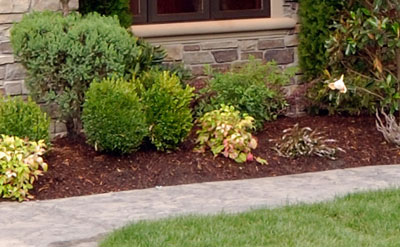 Mulch provides a variety of benefits when used in landscaping. It not only enhances the beauty of landscapes, it also provides several benefits to the soil and plants it surrounds.
Mulch provides a variety of benefits when used in landscaping. It not only enhances the beauty of landscapes, it also provides several benefits to the soil and plants it surrounds.
Benefits Include:
- Improves the soil structure and increases the fertility of soil by providing positive effects on soil moisture and temperature.
- Suppresses weed growth, including perennial weeds, by preventing sunlight from reaching the soil's surface.
- Creates a protective zone to buffer plants from damaging effects of traffic and lawn equipment.
Be Careful Not to Over Mulch
Although mulch can provide a variety of benefits as listed above, there is a downside to having too much mulch. Over mulching can provide negative effects on the plants and trees, including:
- Excessive moisture in the root zone, which causes stress on the plant
- Insect and disease problems
- Deficiencies in nutrients
- Weed growth
- Smelly planting beds caused by anaerobic conditions
- Creates a habitat for rodents that chew bark and cause damage to trees
Proper Way to Mulch
To ensure the health of your trees and plants, the following tips provide basic steps to make certain you are properly mulching your landscapes.
- Apply a 2- to 4-inch layer of mulch. Make certain the area is able to properly drain.
- If the existing layer of mulch meets depth requirements, do not add mulch to the top. Instead, rake the old much to break up the matted layers and refresh the appearance.
- Proper way to mulch around trees
To determine how much mulch is needed for an area, view a detailed coverage chart.
